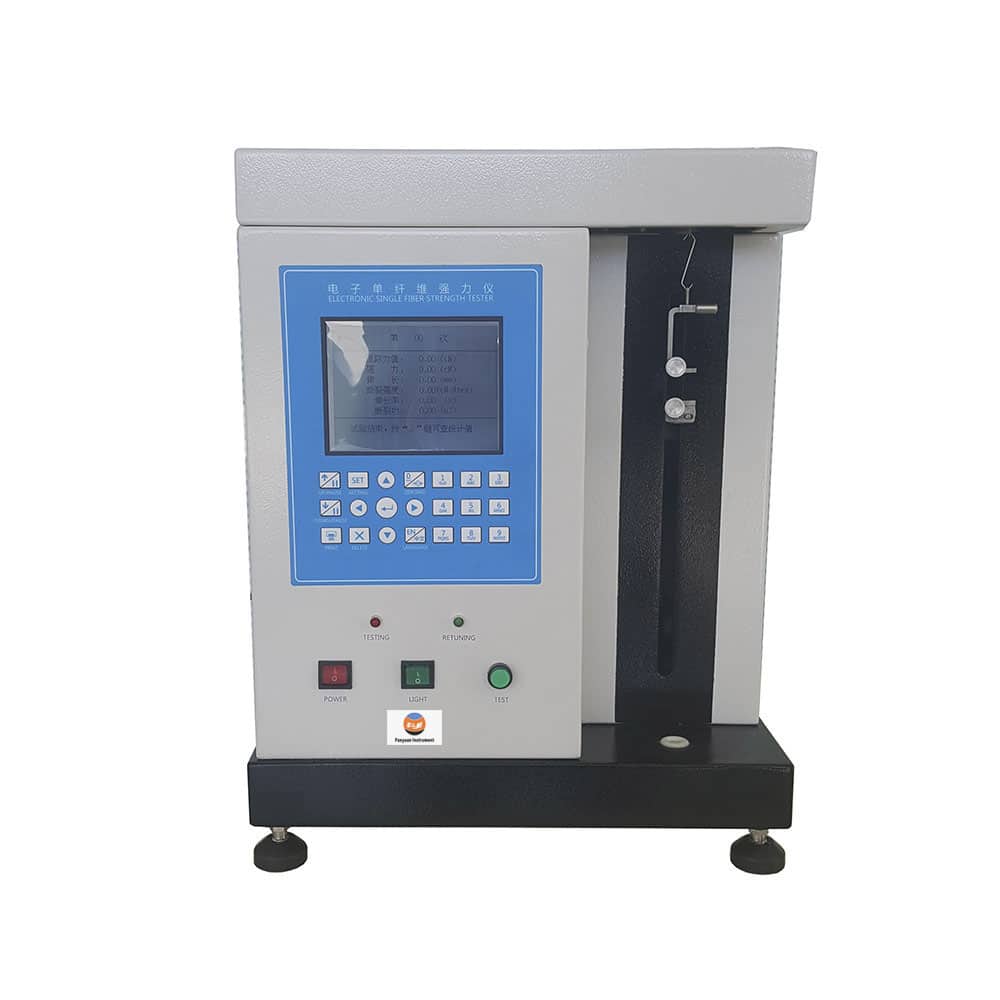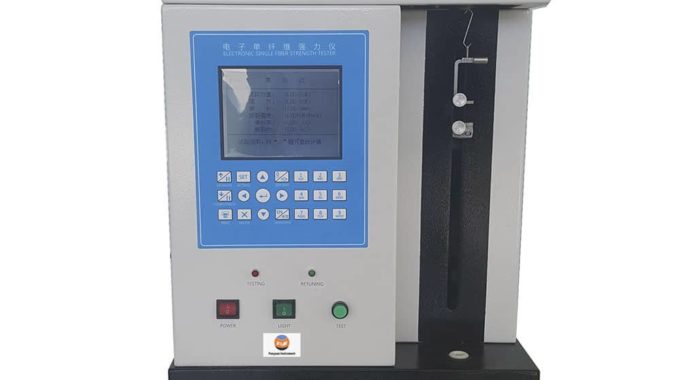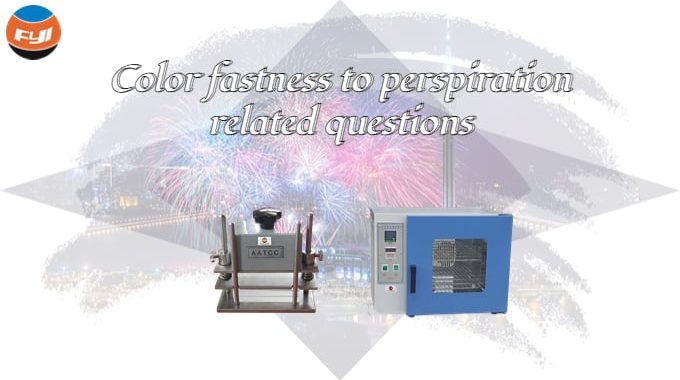
Fiber Strength and Tester in Textile
Fiber strength refers to the ability of fiber to resist external damage, which largely determines the durability of textile products.
Common indicators
Fiber strength: Absolute strength, the maximum load that a fiber material can bear when it is stretched to break. Unit: Newton, Centinewton (1 Newton = 102 centinewton).
Elongation: Elongation at break, the percentage of the elongation of the fiber material to the original length before stretching when it is stretched to break.
Constant elongation load: Under specified conditions, the force required to make the fiber material and its products reach a certain elongation. Expressed in Newton.
Specific strength: The strength calculated by unit mass is called specific strength. The specific strength unit is expressed in gf/tex or cN/tex.
Initial modulus: The initial modulus refers to the modulus of the yarn at the point where the external force is equal to the pretension, and refers to the ratio of the stress to the strain of the straight line segment at the beginning of the fiber tensile curve. The size of the initial modulus indicates the ease of deformation of the fiber under a small load, that is, the rigidity of the fiber. The initial modulus of the fiber is an important factor determining its bending performance. Generally, the lower the initial modulus, the softer the fiber, and the more suitable the fabric is for next-to-body wear.
Specific work of breaking: One is the work required to break a unit volume of fiber. Specific power to break by weight Ww refers to the work required to break the fiber material per unit linear density and unit length.
The coefficient of variation is a statistic that measures the degree of variation of each observation. When comparing the degree of variation of two or more data, if the measurement unit is the same as the mean, the standard deviation can be directly used for comparison. If the unit and (or) the mean are different, the standard deviation cannot be used to compare the degree of variation, but the ratio (relative value) of the standard deviation to the mean should be used for comparison. The ratio of the standard deviation to the mean is called the coefficient of variation
Factors Affecting Cotton Fiber Strength
Planting time
If the sowing date is early, the fiber growth will be poor, which will easily lead to yield reduction; if the sowing date is late, the maturity of cotton will be insufficient, which will affect the fiber quality.
Growing conditions
The formation of cotton fiber strength is formed by the thickening and growth of the secondary wall of the ovule cells in the flower bud stage between the boll stage and the boll stage. Depending on the cotton variety and growing conditions, the timing of secondary wall thickening varies. Thus, the thickness of the cell wall is directly determined by the cellulose deposition, and the crystallinity of the fibers is determined by the arrangement of the fibers. The pore wall thickness and crystallinity of fibers are the structural basis of strength. If the secondary wall fibers are deposited prematurely, after a long period of time, the growth environment is suitable, the maturity of cotton is good, the crystal structure of cotton cellulose increases, and the fiber strength is high; otherwise, the strength is low.
Pick
Scientific and timely picking can make cotton grades into different layers. Mixed picking and mixed harvesting will cause cotton with different breaking strength to be mixed together, which will affect the use value of cotton.
Store
1. The freshly picked cotton should be sun-dried in time, which has a high water content. If it is not sun-dried in time and stored, it will not only affect the grade and color of the cotton, but also mildew and deteriorate, which will significantly reduce its strength. Therefore, it should be spread out in time, and it should be spread out indoors in case of cloudy and rainy days.
2. Safe storage The quality change of cotton fiber during storage is mainly caused by the change of ambient temperature. Because cotton fiber has good hygroscopic properties, changes in environmental humidity will inevitably cause an increase or decrease in the moisture content of cotton fibers, resulting in changes in cotton quality.
Test conditions
1. The inhomogeneity of the cross-section and structure of the sample length cotton fiber leads to different strengths on each fiber. The fracture always occurs at the weak ring, and the measured strength is actually the strength at the weak ring. When the length of the sample is short, the chance of the weakest weak link being tested will be less, so the average strength will be increased, so different strength machines have specified the corresponding length of the sample, and the test should be carried out strictly according to the requirements to ensure the correctness of the obtained results.
2. The number of samples The strength of each fiber in the sample, especially its elongation ability is inconsistent, and the straightening state is also different. Under the action of external force, the fibers with low elongation, poor strength, and relatively straight are broken first, and then the external force is borne by other fibers. Therefore, each fiber does not break at the same time. When performing a bundle fiber strength test, As the number of fibers in the sample increases, the measured strength will decrease, so the measured strength of the bundle of fibers must be corrected. The fiber fineness of the same variety of cotton is closely related to the degree of maturity, the higher the degree of maturity, the coarser the fiber fineness; the lower the degree of maturity, the finer the fiber fineness. Therefore, when the cotton fiber is thick, it means that the cotton fiber is too mature, and its strength is not necessarily high; when the cotton fiber is thin, the maturity is poor, the fiber strength is low, and the cotton fiber fineness is moderate; when the maturity is normal, its strength is high.
Moisture regain
The existence of water molecules in cotton fibers must have certain temperature and humidity conditions. The water molecules in the cotton fiber and the water molecules in the air are in an equilibrium state, that is, the cotton fiber with a small moisture content absorbs water molecules in the air, and the cotton fiber with a large moisture content releases water molecules in the air. Until the water molecule content in the cotton fiber no longer changes significantly, and the humidity has tended to be stable, this part of the water molecule will remain in the cotton fiber. After the cotton fiber absorbs more water, its strength also increases, which is related to two factors: the degree of polymerization and the crystallization area of the cotton fiber. Cotton fiber has a high degree of polymerization, and its non-crystalline region only accounts for about 30%, and its macromolecular chain is extremely long. When the amorphous region in the cotton fiber absorbs water molecules, it does not affect the overall molecular structure of the cotton fiber. Under the higher action of the macromolecular chain, not only does not weaken the gravitational force, but it can be strengthened, which is reflected in the sliding ability. That is, when the cotton fiber absorbs more water, the sliding ability between microfibrils or between macromolecules is enhanced, and the strength uniformity between microfibrils and macromolecules is adjusted. As a result, the number of stress-bearing macromolecules increases, and the fiber strength increases.
Fiber Strength Tester
YG003E / YG005E Electronic Single Fiber Strength Tester
YG003E / YG005E Electronic Single Fiber Strength Tester is used to determine the breaking strength and elongation at break of single textile fibers, such as, cotton, wool, ramie, silk, glass fibber and chemical fibers. It’s a useful fiber testing machine.


YG011 Fiber Bundle Strength Tester (Stelometer)
YG011 Fiber Bundle Strength Tester (Stelometer) is used to check the holding strength and elongation at breakage of fiber tufts. Holding strength reading is on a graduated scale from 0 to 7 kPa (step 0.1kPa), elongation reading is on a graduated scale from 0% to 50%.
KX101 Pressley Fiber Strength Tester
KX101 Pressley Fiber Strength Tester is widely used in the inspection work of international cotton trade handover owing to its exquisite structure, simple operation and fast testing speed. It’s an inclined plane fiber strength tester with a free-sliding hammer designed to break flat bundle of cotton fibers and to indicate the load required to cause the rupture of the flat bundle. Based on the principle of moment balance, the breaking load value of cotton fiber is indicated by the sliding distance of the hammer travels on the track
Comments are closed.



The author’s storytelling ability shines through in this captivating and educational blog post.
Lot of articles out there, but this one stands out for its clarity, depth, and well-structured arguments.
The author did a great job of presenting both sides of the argument, allowing readers to form their own opinions based on the evidence presented.
Go ahead and bookmark this blog—you’ll want to come back for more.
Need a reliable source of information? This blog covers it all, leaving no question unanswered.